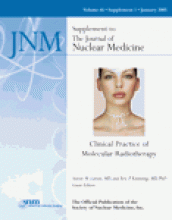Abstract
Nephrotoxicity is the major limiting factor during therapy with the radiolabeled somatostatin analog 90Y-1,4,7,10-tetraazacyclododecane-N,N′,N″,N‴-tetraacetic acid (DOTA)-d-Phe1-Tyr3-octreotide (DOTATOC). Pretherapeutic assessment of kidney absorbed dose could help to minimize the risk of renal toxicity. The aim of this study was to evaluate the contribution of patient-specific adjustments to the standard dosimetric models, such as the renal volume and dose rate, for estimating renal absorbed dose during therapy with 90Y-DOTATOC. In particular, we investigated the correlation between dose estimates and effect on renal function after therapy. Methods: Eighteen patients with neuroendocrine tumors (9 men and 9 women; median age, 59 y) underwent treatment with 90Y-DOTATOC (8.1–22.9 GBq) after pretherapeutic biodistribution study with 86Y-DOTATOC. Kidney uptake and residence times were measured and the absorbed dose (KAD) was computed using either the MIRDOSE3.1 software assuming a standard kidney volume (KADStdVol) or the MIRD Pamphlet 19 values and the actual kidney cortex volume determined by pretherapeutic CT (KADCTVol). For each patient, the biologic effective dose (BED) was calculated according to the linear quadratic model to take into account the effect of dose rate and fractionation. Renal function was evaluated every 6 mo by serum creatinine and creatinine clearance (CLR) during a median follow-up of 35.5 mo (range, 18–65 mo). The individual rate of decline of renal function was expressed as CLR loss per year. Results: KADCTVol ranged between 19.4 and 39.6 Gy (mean, 28.9 ± 5.34 Gy). BED, obtained from KADCTVol, ranged between 27.7 and 59.3 Gy (mean, 40.4 ± 10.6 Gy). The CLR loss per year ranged from 0% to 56.4%. In 12 of 18 patients, CLR loss per year was <20%. No correlation was observed between CLR loss per year and the KADStdVol or the KADCTVol. In contrast, BED strongly correlated with CLR loss per year (r = 0.93; P < 0.0001). All 5 patients with CLR loss per year >20% received a BED >45 Gy. Patients who were treated with low fractionation were those with the highest rate of renal function impairment. Conclusion: Radiation nephrotoxicity after 90Y-DOTATOC therapy is dose dependent. Individual renal volume, dose rate, and fractionation play important roles in an accurate dosimetry estimation that enables prediction of risk of renal function impairment.
Footnotes
Received Sep. 8, 2004; revision accepted Nov. 2, 2004.
For correspondence or reprints contact: Stanislas Pauwels, MD, PhD, Centre de Médecine Nucléaire, Université Catholique de Louvain, UCL 54.30, Avenue Hippocrate, 54, B-1200 Brussels, Belgium.
E-mail: stanislas.pauwels{at}mnuc.ucl.ac.be







